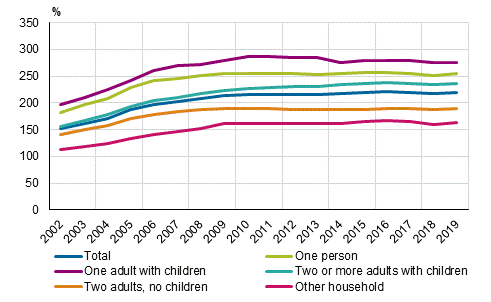Published: 28 January 2021
Debts of household-dwelling units with housing loans are more than double their annual income
In 2019, household-dwelling units with housing loans had, on average, 220 per cent of their disposable annual monetary income in debts. Debts relative to income were highest for single-supporter families, 276 per cent, and household-dwelling units with one adult, 255 per cent. The indebtedness ratio of two-supporter families with children was also higher than average, 237 per cent. The average size of the housing loan per household-dwelling unit with a housing loan was EUR 102,240, which was 1.2 per cent more than in 2018.
Rates of indebtedness of household-dwelling units with housing loans by type of family in 2002 to 2019, %

In 2019, there were 1.45 million indebted household-dwelling units, that is, 53 per cent of all household-dwelling units. Their total debt amounted to EUR 126.9 billion, which in real terms was 2.1 per cent more than in 2018. Household-dwelling units' disposable monetary income grew by 1.6 per cent from the previous year. In 2019, the rate of indebtedness of all household-dwelling units was 111 per cent, as it was in the previous year.
Of household-dwelling units' debts, EUR 89.6 billion were housing loans, EUR 8.9 billion were loans taken out for business purposes, and EUR 28.4 billion were other debts. Other debts include debts taken out for consumption and larger purchases and study loans. Debts taken out for business purposes grew most from the previous year, by 7.2 per cent. Other debts of household-dwelling units increased by 4.2 per cent and housing loans by one per cent from the year before.
Two-supporter families with children were the most common housing loan holders. Seventy-one per cent of them had housing loans. The housing loans of families with children were larger than those of childless household-dwelling units. Two-supporter families with children had, on average, EUR 138,700 in housing loans and single-supporter families EUR 92,140. Childless household-dwelling units had smaller housing loans, but their indebtedness varied considerably by age. Childless household-dwelling units with two adults had, on average, EUR 89,300 in housing loans and one-person household-dwelling units EUR 69,520.
Household-dwelling units with housing loans with a debt at least three times as high as their annual income numbered 246,000, or 28 per cent of household-dwelling units with housing loans in 2019. Large housing loans relative to income were found most among household-dwelling units in Åland, Greater Helsinki and elsewhere in Helsinki-Uusimaa. Forty-one per cent of the household-dwelling units with housing loans in Åland, 38 per cent in Greater Helsinki and 32 per cent elsewhere in Helsinki-Uusimaa had debts that were at least triple compared with their annual income. The number of large housing loans was lowest in Southern Finland and Northern and Eastern Finland, where under one quarter of household-dwelling units with housing loans had debts of at least three times as much as their annual income.
Large debts relative to income were more common the lower the income of the household-dwelling unit was. Of the household-dwelling units belonging to the lowest income quintile, 41 per cent had debts that were at least triple compared with their annual income, while 24 per cent of the household-dwelling units in the highest income quintile had that much debt. On average, household-dwelling units with housing loans belonging to the lowest income quintile had EUR 63,720 in housing loans and those in the highest income quintile EUR 135,190.
In 2019, household-dwelling units paid a total of EUR 1.6 billion in interests, which in real terms was two per cent less than in the year before. Of them, EUR 842 million were interest expenses for housing loans, five per cent less than in the year before. In 2019, interest expenses per household-dwelling unit with a loan were EUR 1,130, on average. Interests on housing loans per household-dwelling unit with a loan were EUR 960, on average.
Source: Indebtedness 2019. Statistics Finland
Inquiries: Auli Hämäläinen 029 551 3615, Hannele Orjala
Publication in pdf-format (172.7 kB)
- Tables
-
Tables in databases
Pick the data you need into tables, view the data as graphs, or download the data for your use.
Updated 28.1.2021
Official Statistics of Finland (OSF):
Indebtedness [e-publication].
ISSN=2489-3285. 2019. Helsinki: Statistics Finland [referred: 31.12.2025].
Access method: http://stat.fi/til/velk/2019/velk_2019_2021-01-28_tie_002_en.html

